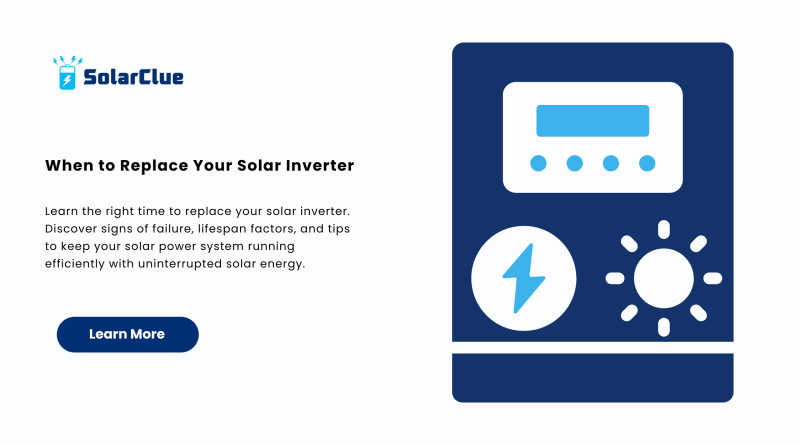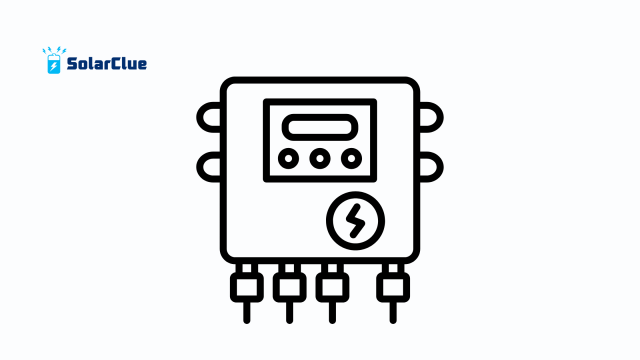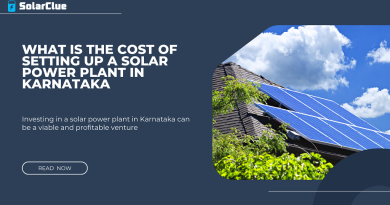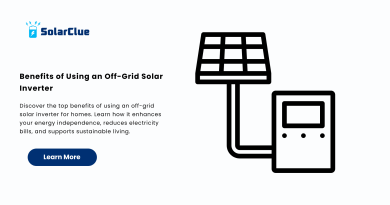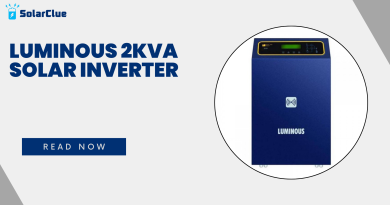When to Replace Your Solar Inverter
The heart of any solar power system is the solar inverter. While solar panels capture sunlight and generate electricity, the inverter converts that direct current (DC) into alternating current (AC) for your home or business. Without a functioning inverter, even the most advanced solar panels cannot deliver usable solar energy. Unlike panels that last 25 years or more, inverters generally have a shorter lifespan, usually 10–15 years. That’s why it’s crucial to know when to replace your solar inverter to avoid interruptions and maintain efficiency.
This guide covers the key signs of inverter failure, factors that affect lifespan, the consequences of delaying replacement, and practical tips to extend the life of your inverter. By the end, you’ll have clear answers to ensure your solar power system continues running smoothly.
Table of Contents
- 1 Why Solar Inverters Matter in a Solar Power System
- 2 Average Lifespan of a Solar Inverter
- 3 Signs That It’s Time to Replace Your Solar Inverter
- 4 Repair vs. Replace: Which is Better?
- 5 Factors That Affect Solar Inverter Lifespan
- 6 Consequences of Delaying Solar Inverter Replacement
- 7
- 8 How to Choose a Replacement Solar Inverter
- 9 Tips to Extend the Life of Your Solar Inverter
- 10 FAQs on Solar Inverter Replacement
- 11 Conclusion
Why Solar Inverters Matter in a Solar Power System
An inverter is often referred to as the “brain” of a solar power system because it does more than just convert electricity. It:
-
Manages the flow of electricity between your solar panels, batteries, and the grid.
-
Tracks and optimizes energy production to maximize efficiency.
-
Provides monitoring and error alerts to identify issues.
-
Ensures safety by shutting down the system during faults.
Given its central role, inverter performance directly impacts how much solar energy your system can generate and how much money you save on electricity bills.
Average Lifespan of a Solar Inverter
Most modern inverters are built to last 10 to 15 years, depending on type and maintenance. Unlike solar panels, which have fewer moving parts and degrade slowly, inverters work continuously and endure stress from fluctuating voltage and environmental conditions. Here’s a quick overview of common inverter lifespans:
-
String Inverters: 10–12 years on average.
-
Microinverters: 15–20 years due to distributed design.
-
Hybrid/Smart Inverters: Around 10–15 years, depending on usage.
Understanding these timelines can help you plan ahead for replacement.
Signs That It’s Time to Replace Your Solar Inverter
1. Reduced Energy Output
If your solar power system is producing significantly less electricity than before, and panel efficiency is not the issue, the inverter may be underperforming. Regularly compare actual output with expected levels to identify drops in performance.
2. Error Codes and Warning Lights
Inverters are designed with built-in error detection. Frequent error codes, blinking lights, or warning messages on the display indicate technical problems that may require replacement rather than repair.
3. Strange Noises
A properly functioning inverter is usually quiet. Buzzing, clicking, or humming sounds often mean internal electrical issues or capacitor failure.
4. Overheating
Inverters should remain relatively cool with proper ventilation. If you notice overheating or the inverter shutting down during hot days, it’s a red flag. Overheating accelerates wear and shortens lifespan.
5. Age of the Inverter
Even if your inverter appears functional, replacement may be necessary if it is approaching or has exceeded its average lifespan. Proactive replacement ensures uninterrupted solar energy production.
6. Physical Damage
External signs like burnt marks, corrosion, or cracked casing suggest serious internal damage. Delaying replacement can compromise safety and efficiency.
Repair vs. Replace: Which is Better?
Sometimes, minor inverter issues can be repaired. For example, replacing a fan, capacitor, or small component may restore functionality. However, replacement is a better option when:
-
The inverter is over 10 years old.
-
Repair costs are close to the price of a new inverter.
-
The system requires frequent servicing.
-
You want to upgrade to a more efficient model with advanced monitoring features.
Replacing your inverter at the right time ensures your solar power system delivers maximum returns and avoids unexpected breakdowns.
Factors That Affect Solar Inverter Lifespan
-
Quality of the Inverter: Higher-quality brands typically last longer and perform better.
-
Installation Conditions: Inverters installed outdoors in hot, humid, or dusty conditions wear out faster.
-
Maintenance Practices: Regular cleaning and inspections extend lifespan.
-
Load Demand: Systems that frequently operate near maximum capacity stress the inverter more.
-
Technology Type: Microinverters last longer as they distribute the load across multiple units.
By understanding these factors, you can take steps to extend the inverter’s useful life.
Consequences of Delaying Solar Inverter Replacement
Postponing replacement when signs of failure are evident has serious downsides:
-
Loss of Solar Energy: Your system may generate power but fail to deliver usable electricity.
-
Higher Electricity Bills: You’ll end up relying more on the grid.
-
Potential Safety Risks: Faulty inverters may overheat or cause electrical hazards.
-
Reduced ROI: The longer your system stays inefficient, the lower your overall return on investment.
Timely replacement is not just about convenience—it’s about protecting your financial and environmental investment.
How to Choose a Replacement Solar Inverter
Match Capacity with Your Solar Power System
Ensure the new inverter matches your panel capacity. Undersized inverters reduce efficiency, while oversized ones may cost more than necessary.
Opt for Advanced Features
Modern inverters come with features like remote monitoring, higher efficiency ratings, and hybrid support for batteries.
Warranty and Support
Look for inverters with at least a 10-year warranty and reliable after-sales service.
Consider Future Upgrades
If you plan to expand your system, choose an inverter that allows for scalability.
Tips to Extend the Life of Your Solar Inverter
-
Install in shaded or well-ventilated areas to prevent overheating.
-
Keep the inverter clean and free from dust.
-
Check and tighten connections annually.
-
Monitor system performance daily through apps or displays.
-
Schedule professional maintenance every 1–2 years.
With proper care, your inverter can serve you longer and ensure steady solar energy supply.
FAQs on Solar Inverter Replacement
Q1: How long does a solar inverter last?
A: On average, 10–15 years, depending on type and maintenance.
Q2: Can I replace a solar inverter myself?
A: No, inverter replacement involves electrical work that should always be done by a certified professional.
Q3: What happens if my inverter fails completely?
A: Your solar power system stops delivering usable electricity until the inverter is repaired or replaced.
Q4: How much does a new solar inverter cost?
A: Costs vary by capacity and brand but generally range between ₹50,000 to ₹1,50,000 in India.
Q5: Should I upgrade to a hybrid inverter?
A: Yes, if you plan to add battery storage in the future, a hybrid inverter is a smart investment.
Conclusion
Knowing when to replace your solar inverter is essential for keeping your solar power system running efficiently and ensuring you get the most out of your investment in solar energy. By recognizing early signs of failure, understanding lifespan factors, and planning timely upgrades, you can avoid downtime, save on electricity bills, and continue enjoying the benefits of clean energy.
If you’re looking for expert advice on solar products or want to explore the best options for your next upgrade, visit us at solarclue.com and blog.solarclue.com—because your solar journey deserves guidance as reliable as the sun itself.

